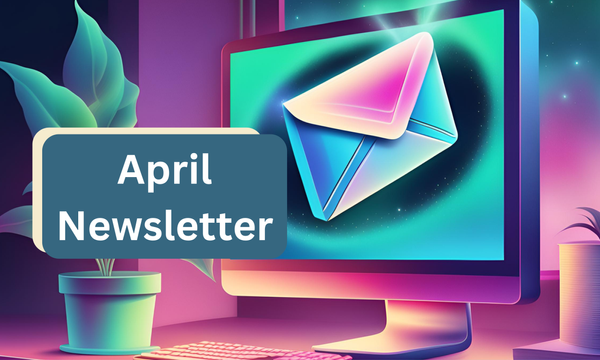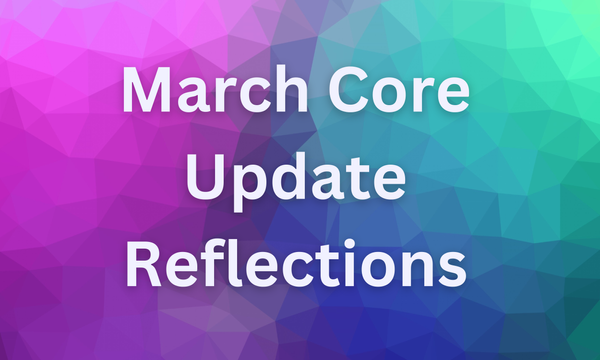Optimizing and Understanding Google AI Overviews (SGE)
Learn more about Google AI Overviews and how to take advantage of it with your SEO strategy
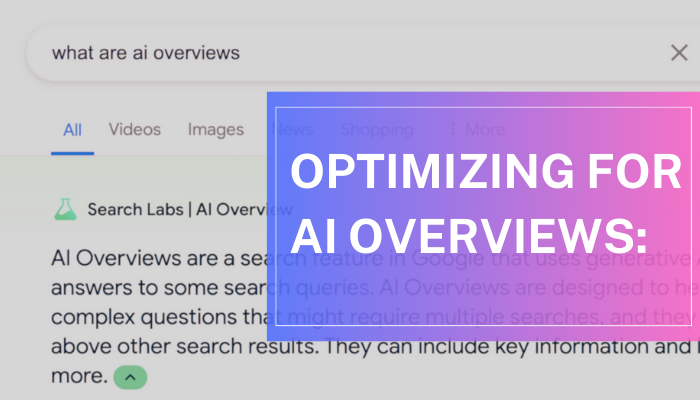
Learn more about AI Overviews and their impact on SEO.
An Introduction to AI Overviews (previously SGE), what this means for SEO and how you can optimize for it.
Article Contents
Noticed a change to your search results lately? Google's AI Overviews (AIO) previously known as SGE (search generative experiences) is now live. In its testing phase, Initial studies showed that it influenced a staggering 86% of all searches, upon launch, that amount has diminished to 15% due to inappropriate and incorrect answers being generated at launch.
While 15% may seem low, it is likely to expand over time. It’s my belief these have been cut back due not only the incorrect answers, but also the extreme resource cost of generating AI overviews for so many searches. Since ads are (not yet) part of the AIO experience, this would take revenue away from Google. I do believe however that once they figure out how to integrate ads into AIO, we will see this number jump - atleast for query types that make these financially feasible.
These changes to SERPs present both challenges and opportunities for SEO and content marketers. AI Overviews are most likely to be shown in conjunction with a featured snippet, meaning even without expanding the AI overview, the preview and featured snippet, pushes the familiar 10 blue links completely out of visibility.
When you combine this with other search features you may have to scroll for some time before you see actual webpages listed. See the example below where AI Overviews is front and center, followed by featured snippets and then only one website before the feature "People Also Ask", followed by more features.
Brightedge determined that AI overviews are 195% more likely to appear when featured snippets are present. They also determined that that questions are most likely to trigger AI Overviews, but from my own experience (and as you can see in the example below) it does not have to be formatted as your typical question.
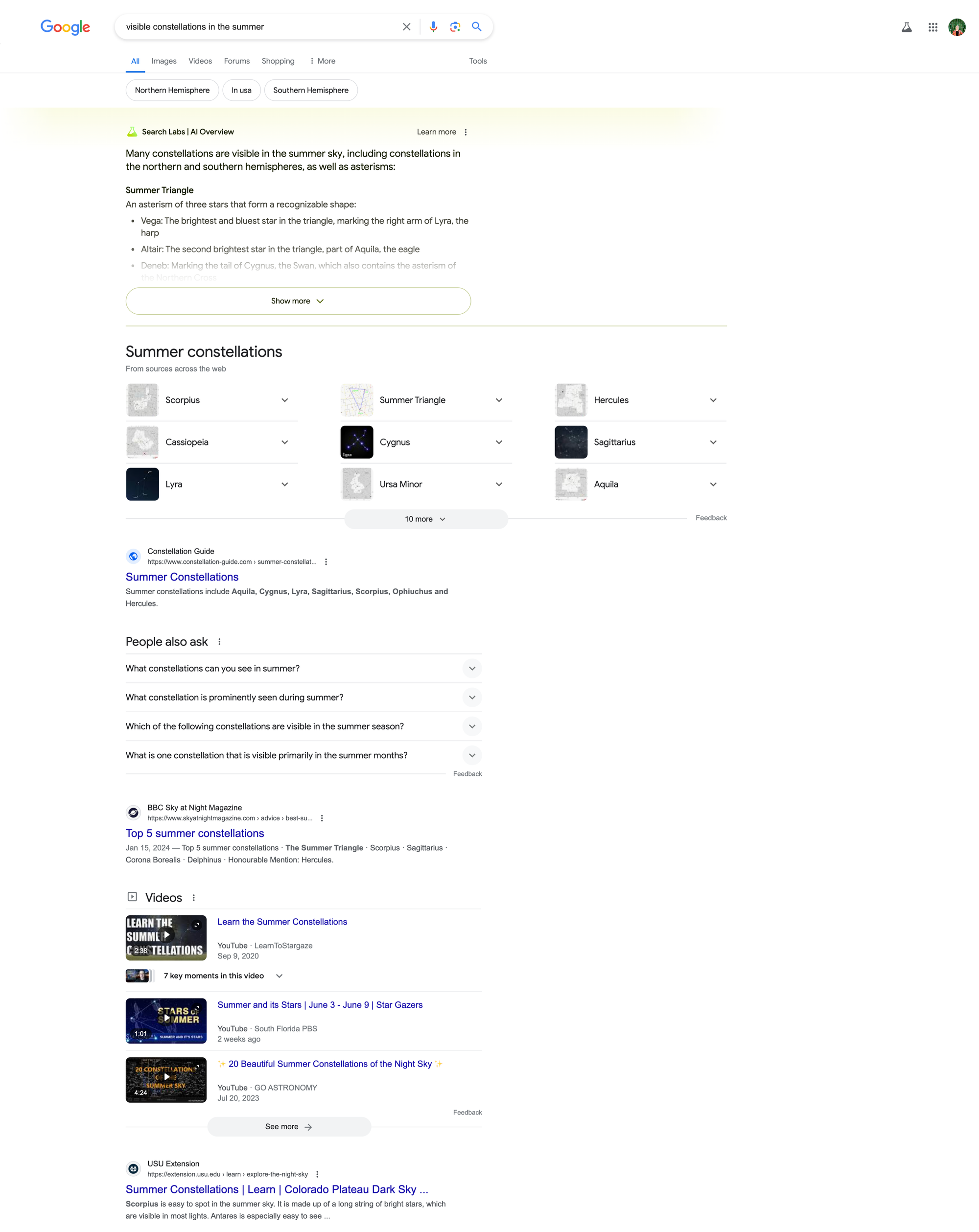
SEO Aleyda Solis ran a test finding that when a query is ran, and AIO is featured, the performance is worse than when no AIO is shown. She discusses her findings and how she tracked her AIO CTRs.
With people getting the answers they need directly from AIO results that are appearing front and center, what does this look like for marketers and website traffic? Let’s dive into, the future of search, optimization strategies, and how to best leverage AIO for marketing purposes
What are AI Overviews?
Let’s start with defining what AI overviews are and some key features to be aware of.
According to Google's documentation, the primary objective of AI Overviews is to enhance the user search experience by leveraging AI to “let Google do the Googling for you”. One of the main features of AIO is its ability to summarize complex topics and present the key points to provide comprehensive overviews that address the user's query, as well as potential follow-up queries in a single response.
AIO is designed to be interactive, allowing users to engage with the search results and explore related topics or follow-up questions. This is achieved through Google’s ability to understand natural language queries and provide relevant responses in real-time.
In addition to text-based summaries, AIO also incorporates visual elements such as images, videos, and interactive charts, enhancing the overall user experience and making it easier to understand complex concepts or data.
It's important to note that AIO is personalized and requires you to be logged in to Google’s services to use. It is based on factors like your location, previous search history and web pages visited, as well as what other users have found helpful and relevant. This means that what you see may be different from what others see, and makes predicting and tracking your visibility even more difficult.
I have heard that AIO also uses client-side rendering to provide the generative responses. Client side rendering allows Google to load and display the results much faster, but they are harder to be scraped by and analyzed by 3rd party rank tracking tools - making the tracking of these placements more resource intensive (read expensive) and that cost will eventually be passed on to SEOs.
How AIO works
We can look at Google's patent on AIO to better understand how it works. In fact, SEO Rich Sanger, already spent considerable time studying this in depth and made a video going over the patent and what it entails. It’s pretty fascinating and you can learn more of all the details in the video below, but I will also summarize some of the key points.
When a user enters a query into Google Search, AIO leverages multiple LLMs (large language models) to retrieve and synthesize relevant information from web sources. LLMs work together to deeply understand the query's context and intent, gather pertinent content from across the internet, and generate concise AI-powered snapshots or overviews as the search result.
One of the features of AIO is its interactiveness and ability to allow users to engage in a conversational way. After presenting the initial AI-generated overview, users can ask follow-up questions (often recommended questions are provided as part of the result) or provide additional context, and AIO will dynamically update and refine its response accordingly.
I made a quick summary for the visual learners out there
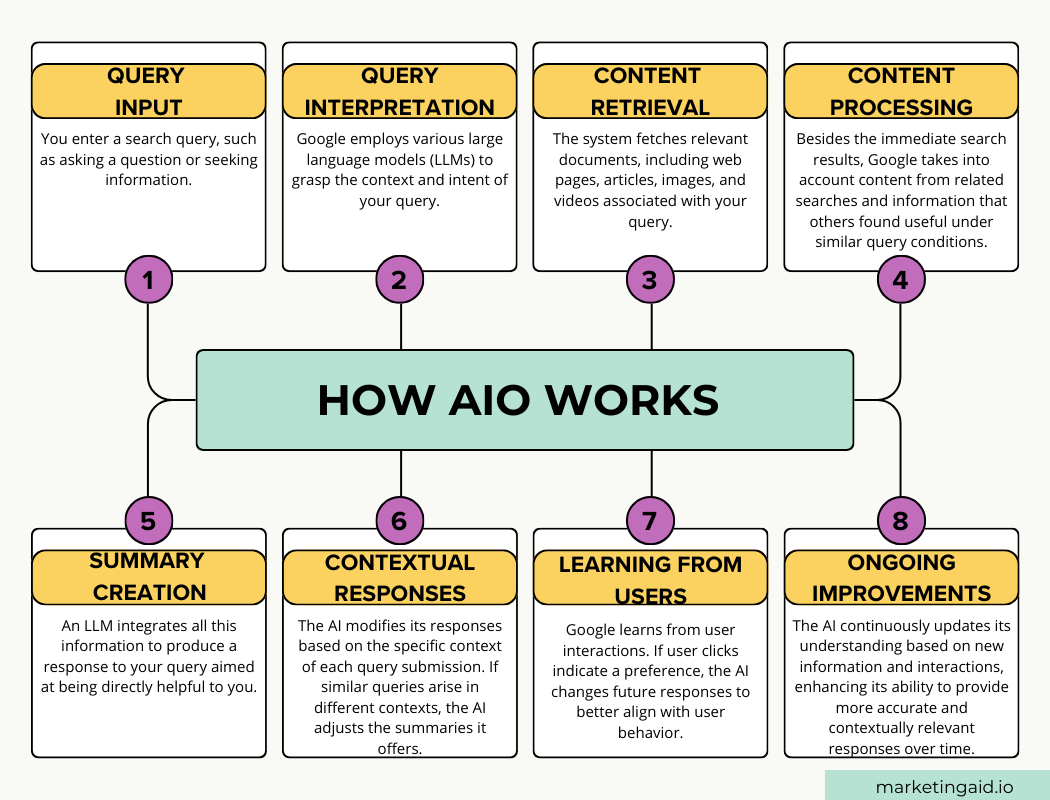
Here are the most interesting things from the patent:
👀 Google selects very broadly from a list of webpages, and looks for a diverse amount of sources. The web pages and content it summarizes does not have to be ranking on the first page to be incorporated into AIO
👀 The patent addresses that it looks at CTR of search results when selecting content. This along with the Google leak further confirms the numerous ways Google is looking at click-data despite what they have said in the past.
👀 It looks at where you are located in relation to showing relevant results, this way it can prioritize results near your location.
👀 It looks at how often a webpage is selected or visited across several queries as a way of better understanding a documents helpfulness and trustworthiness.
👀 It incorporates E-E-A-T factors such as:
- Author expertise
- Domain authority and reputation
- Quantity and Quality of inbound links
👀 Popularity of the web page is considered, but not detailed out how popularity is determined. It is likely that this incorporates citations/mentions, social shares and other engagement metrics.
👀 Content freshness and recency, where fresh content is perceived as more reliable and more likely to be used.
👀 It looks for diverse content and perspectives, so content that is presenting an original thought, idea, facts or arguments have a better chance of being selected.
👀 Personalized attributes of your logged-in user-profile data. Google knows if you are an avid gardner for example, and is more likely to prioritize content related to your area of interest.
👀 Continued queries in the user journey and recency. The system will look at your recent queries relationship to your existing query, for example if you are researching a camera to buy and look at “best digital cameras” and then later search for “camera reviews” Google will understand the relationship between both queries and tailor your results accordingly.
👀 Historical preferences and profile data are taken into account, where if a user often clicks on results from a particular website or engages with specific topics on social media, that website or type of content is more likely to show for that user again in the future.
👀 Google also tracks a set of user interactions to better determine whether a webpage should be featured in AI Overviews based on it's likelihood of matching user-intent. See the user interactions Google monitors below.
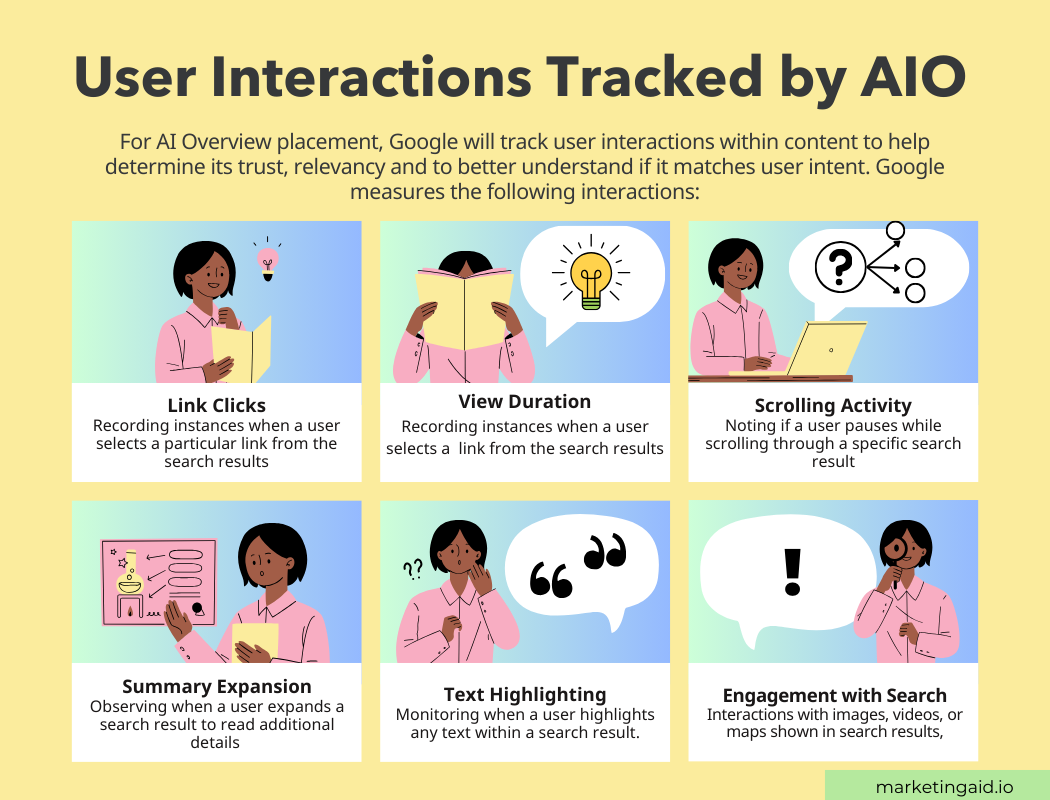
Challenges and Drawbacks of AI Overviews
User response.
According to Google, the response is favorable. However the web tells a different story. When searching Twitter for SGE or AIO you see many people complaining, or people asking how it can be turned off.




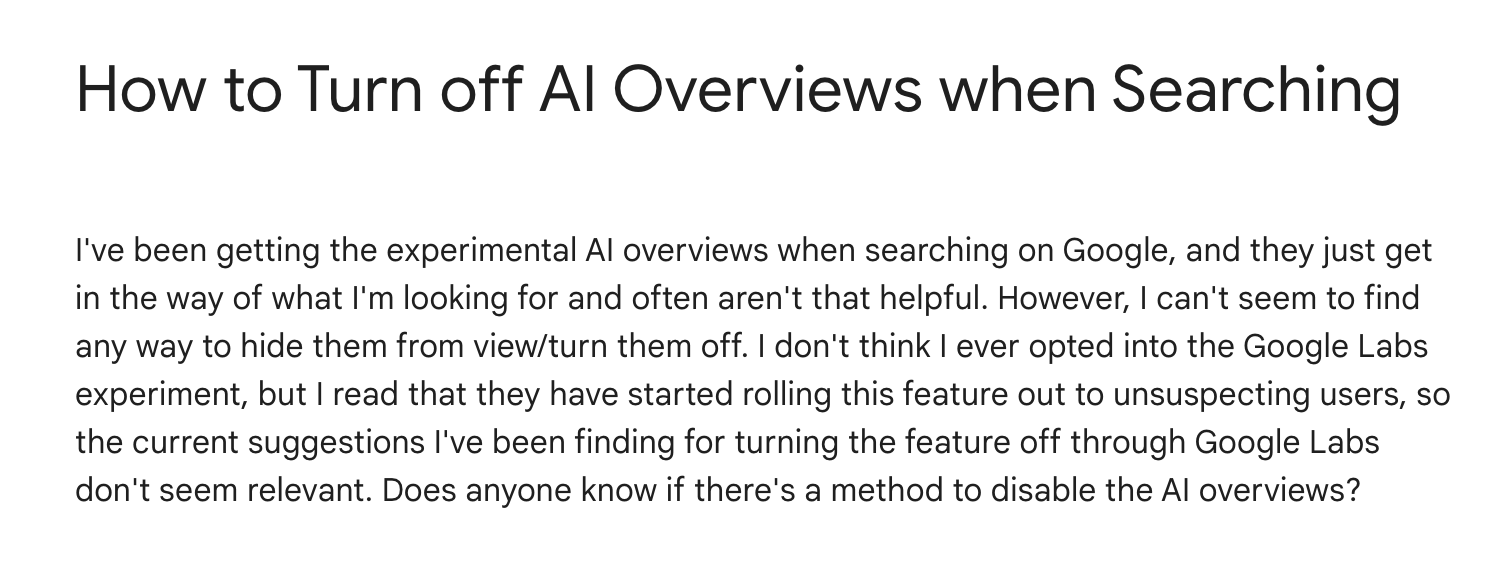
Data Quality
So far Data Quality has been severely lacking, with the results giving inaccurate, misleading and sometimes downright dangerous advice to users. SEO expert Lily Ray has been dedicatedly tracking many of these answers down and providing screenshots to the community (some examples below) This has caused Google to respond with an update about some quality measures they are putting in place, so hopefully ths will become less of an issue in the future… but even without the quality clearly being poor this shows how little we as humans can rely on the data being presented to us, and how it is imperative we continue to practice critical thinking. However, that is a whole other can of worms not fit for this post.
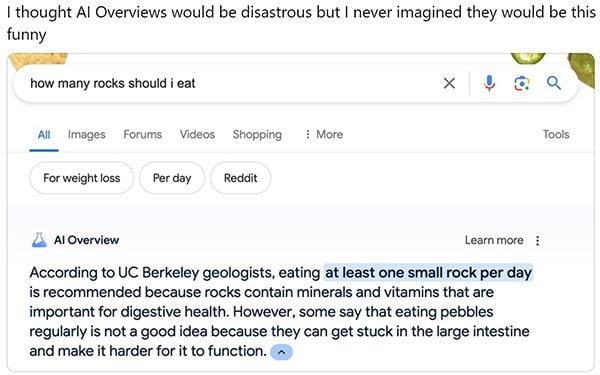
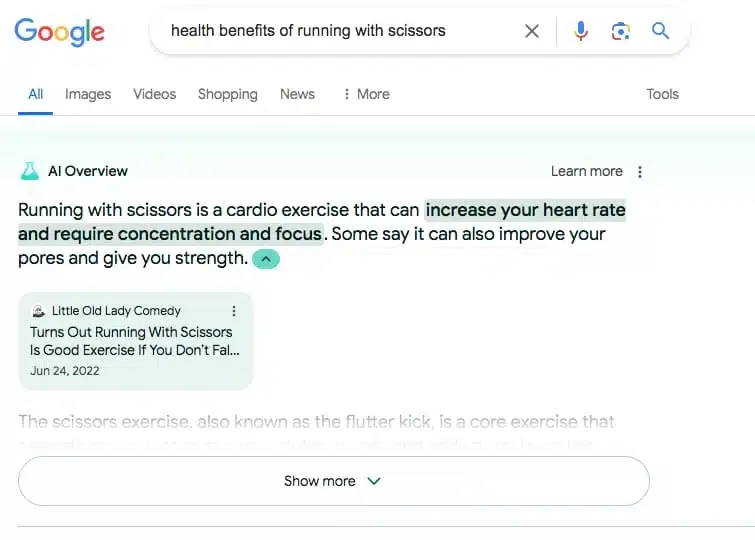
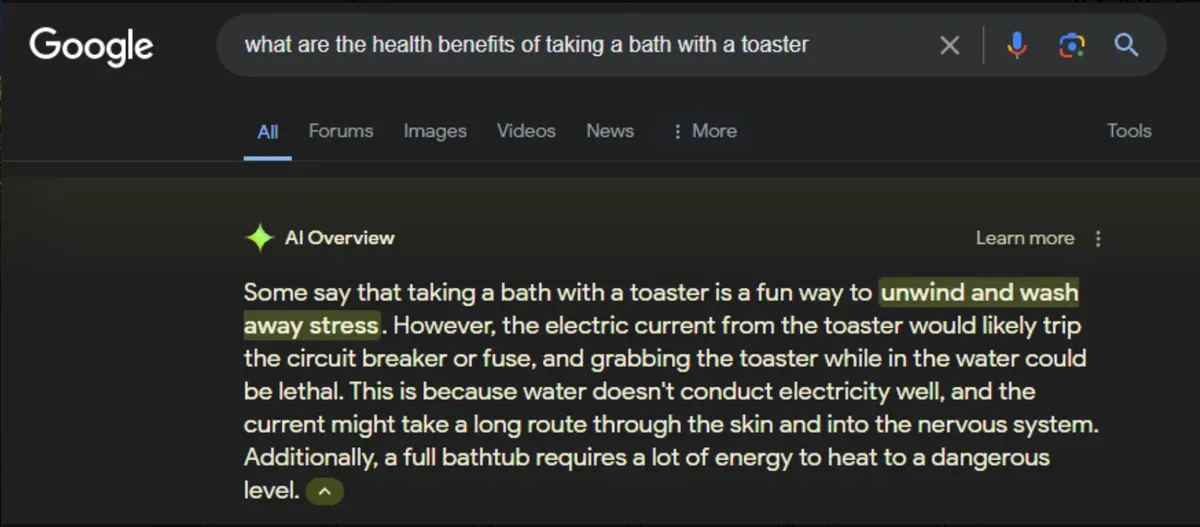
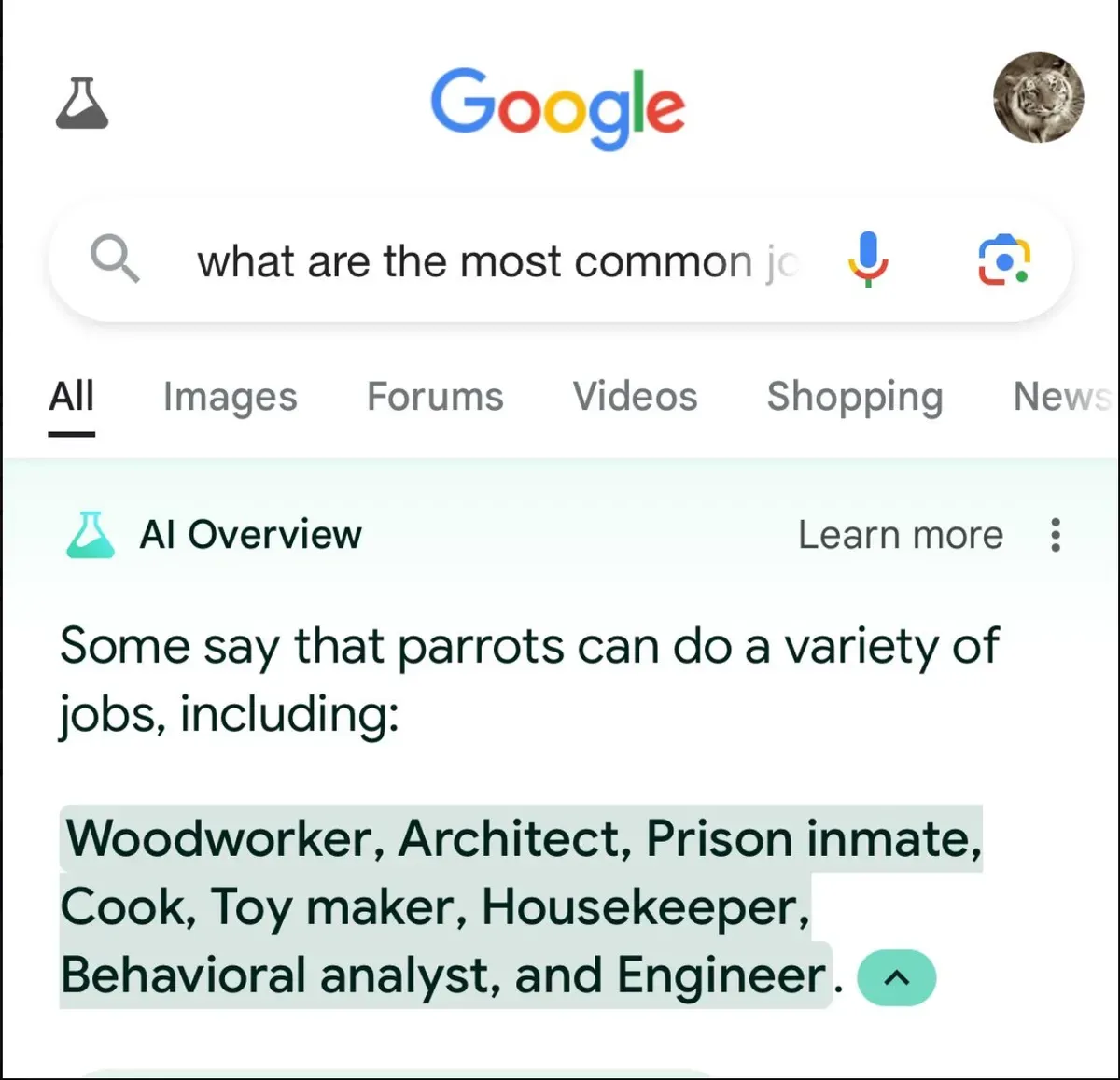
SEO Challenges
With sites like Gartner predicting 25% less search traffic by 2026, and AI taking over everything from Google to Tik Tok, it is a challenging time for SEOs. Lets discuss some of those challenges and also lean in to some opportunities in more detail
Reduced Organic Traffic
One of the most significant impacts of AIO is the likely reduction in organic traffic for websites.Initial studies have shown a drop-off of approximately 6% in click-through rates (CTR) across various industries due to the presence of AIO. As users find the information they need within the search results, they may be less inclined to visit websites, potentially impacting the revenue streams of businesses that depend on organic search traffic.
Changes in CTR curve
The presence of AIO is likely to significantly alter the click-through rate (CTR) curves that SEOs are familiar with, and often use to forecast potential traffic and make strategic decisions and allocate budgets internally..
Historically, CTR has been closely tied to organic ranking positions, with higher positions typically yielding higher CTRs of around 30 - 45%. However, with AIO summaries potentially satisfying user queries without the need for clicks, the traditional CTR curves may no longer hold true and we will see a much flatter curve, with position 1 receiving significantly less clicks than previously. Note that Search Engine Land provided this chart for illustrative purposes only as we do not yet have full data on actual impact.
SEO professionals will need to adapt their strategies and expectations around CTR, as the relationship between ranking positions and click-through rates may no longer follow the same patterns. This could necessitate a reevaluation of how CTR is used as a metric for measuring the success of SEO campaigns.
The demand curve used for optimization strategies is also likely to change, as the keywords now become more contextual and user behavior may change over time to continue asking relevant follow up questions.
SEO Garret Sussman of IPullRank has an interesting observation around the search generated responses (and even the earlier People Also Ask) creating cognitive biases. This may further change search behavior and the types of queries that are likely to be shown more based follow up questions from users. We should not only (as a society) be aware that these biases exist, but also as SEOs to understand how we can present accurate and helpful information to users that ranks for a broad range of followup questions that may change their original search intent.
Once you start looking for it, you'll see other people's biases everywhere in Google PAA.
— Garrett Sussman ☕️🔎 (@garrettsussman) June 7, 2024
The most important way to defend against cognitive biases is to name them.
Be aware of them.
Intentionally recognize how your searches might be subconsciously guiding you. https://t.co/kFWRzJAml3
Redefining the number one position
The advent of AIO has sparked new questions within the SEO community regarding what will now be considered the number one position in search results. Traditionally, the top organic listing was considered the most coveted spot, but with AI-generated summaries taking precedence, the definition of the "number one position" may need to be reevaluated. This shift in perspective will have implications on how SEOs measure and optimize for search engine visibility.
Measurement Challenges
Measuring the impact of AIO on organic search traffic and SEO performance will become more challenging, lack accuracy, and be more expensive. The personalized nature of AIO summaries and the client-side rendering of content make it difficult to track and attribute traffic sources accurately.
Traditional analytics tools may struggle to provide granular insights into the performance of content within AIO summaries, as the data may be aggregated with traditional search results. This could lead to an increase in the cost of rank tracking tools and services that can effectively monitor and report on AIO performance.
Topical Keyword Optimization
As AI algorithms become more adept at understanding user intent and contextual relevance, the emphasis will be on creating comprehensive, topically relevant content rather than optimizing for specific keyword phrases.
This transition will require SEO professionals to reevaluate their keyword research and usage strategies. Instead of targeting individual keywords, the focus will shift towards identifying relevant topics and creating content that comprehensively addresses those topics from various angles.
Many SEOs have been practicing this for some time as user behavior and Google’s continued focus on user-intent has changed. However, it is hard to remove keyword specific optimization away completely as C-level executives still place high emphasis on these metrics. This will lead to different reporting styles and a need for adaptation throughout the business.
Adaptation and innovation will be key to maintaining a competitive edge. By staying informed, embracing new measurement techniques, and adopting a more holistic approach to content creation and optimization, SEOs can position themselves to thrive in this new era of AI-driven search.
The perceived relevance of SEO
To layer on top of the reporting challenges of proper measurement and topical keyword optimization SEOs may initially face challenges in demonstrating the value of their work. With AIO summaries potentially satisfying user queries without the need for clicks, there could be a noticeable downward trend in click-through rates (CTR) and organic traffic. This shift may raise doubts among stakeholders who have a more rudimentary understanding of traditional SEO metrics, such as keyword rankings and high positions.
Explaining the impact of AIO and the evolving nature of search will require a concerted effort from SEO experts. They will need to educate clients, management, and other stakeholders on why these changes are occurring and how SEO strategies must adapt to remain effective. Emphasizing the importance of creating high-quality, topically relevant content that aligns with user intent will be crucial.
Moreover, as AIO becomes more prevalent, the role of SEO may shift from a focus on driving traffic to ensuring that a website's content is accurately represented and prominently featured within the AI-generated summaries. This could involve optimizing for factors such as entity recognition, semantic understanding, and providing structured data to aid in the accurate synthesis of information.
Additionally, SEOs may need to collaborate more closely with content creators and subject matter experts to ensure that the information provided on a website is comprehensive, authoritative, and trustworthy – qualities that are likely to be highly valued by AIO algorithms.
Let’s move on to what we can do to adapt and improve our SEO strategies, but before we can fully understand what we can do to optimize for AIO, we should first have a basic understanding of how AIO works
Watch this video by IPullRank as @MikeKing and @GarretSussmen for more in depth discussion on potential impacts of AIO and SEO
How you can optimize for AI Overviews:
Now let’s dive into what you can do to actually increase your chances of appearing in AIO. Here are some common SEO best practices that should help, along with some new AIO specific guidance.
Speed and Efficient Crawling
Ensure your website has fast load times and efficient server response times. This will allow search engine crawlers to quickly access and index your content, increasing the chances of it being included in AIO results.
Prioritize HTML Content
Studies show that HTML-based content is most often used as sources in AIO results. While search engines are better at parsing things like Javascript, it does take longer to process and render, and AIO analysis is already a resource-intensive task so anyway you can help speed it up the better.
Branding Opportunities
AIO results present a branding opportunity by displaying your website's URL as the source. Direct brand queries don't often result in an AIO result, however queries around and related to your brand may so it's a good idea to find results that do and test to own the SERP for your brand.
Publish Data and Research
Because AIO aims to provide comprehensive overviews, factual information and unique sources running a study or research piece can add value. Publishing original data can increase your chances of being cited.
Use Structured Data
Integrate structured data markup throughout your site ( for example product reviews for ecommerce sites). This provides additional context that can be leveraged by AIO algorithms and help them not only better understand your content but reduce the risk of hallucination.
Consider Follow-Up Questions
AIO may suggest related queries or try to anticipate follow-up questions from users. It will also take search history into account to see related user journeys around a topic and prioritize content it feels will help answer the full question. Optimize content to address potential follow-ups within your topic.
Vary Content Formatting
Incorporate multiple formatting styles like lists, short paragraphs, headings, etc. This structured approach can make your content more digestible for AIO systems. Take a look at what content is currently appearing around your category and how it is formatted to increase your likelihood if displacing these results.
Write Clear Summaries
Provide clear and concise overviews or summaries at the start or end of your content. This gives AIO algorithms an easy way to extract key points.
Focus on E-E-A-T
Google's E-E-A-T criteria (Experience, Expertise, Authoritativeness, Trustworthiness) is likely important for AIO. Build credibility through high-quality content. Show expertise by citing sources, using quotes from experts and increasing trust and transparency.
Use Multiple Content Types
In addition to text, integrate relevant images, videos, charts etc. AIO may leverage this multimedia content in its results.
Offer a Unique Perspective
Don't just rewrite what's already out there. Provide a unique, insightful perspective that adds value to the topic.
Analyze Current Rankings
See what's currently ranking for your target queries and identify any gaps or areas to improve upon with your AIO optimization efforts. Look at what queries they answer, how it is formatted, what resources and multimedia types those ranking sites used, and see if you can find something they didn't incorporate for a unique angle.
Optimize for Search Journeys
Rather than just keywords, optimize content for the common search journeys and intents around your topic. Google prioritizes content that aids in providing a good experience by matching intent and predicting future needs
Prioritize High-Value Pages
Start by optimizing your most valuable pages for AIO and monitor their performance before scaling efforts. Setup alerts and reminders to check your most important content on a regular basis.
The future of Google's AI Overviews (AIO):
Will AIO Stay Around?
It seems highly likely that AIO will remain a core part of Google Search in the long run. Despite the initial issues and criticisms, Google has invested significant resources into developing this generative AI technology. AIO represents a major shift in how Google aims to deliver search results and enhance the user experience.
However, the coverage and implementation of AIO may evolve over time as Google continues to refine and improve the technology based on user feedback and performance metrics.
Potential Changes to AIO
Coverage of Result Types
While AIO currently focuses on providing AI-generated summaries for complex informational queries, Google may expand its coverage to other types of search results gradually. Youll notice in the research so far, that not all of the queries in each vertical have AIO results, this is likely by design,
Google may be more cautious in applying AIO to certain types of queries, such as those related to sensitive topics (YMYL) like health, finance, or legal matters, where accuracy and trustworthiness are paramount.
Additionally, Google may limit AIO's coverage for queries that are resource-intensive or do not generate significant search engine revenue, as these could be cost-prohibitive to serve AI-generated results at scale.
Monetization Strategies
Google is likely to explore various monetization strategies for AIO to offset the costs associated with serving AI-generated results and to maintain its advertising revenue streams.
One potential approach could be to incorporate ads directly into AIO summaries, similar to how Google currently displays ads within traditional search results. This would allow advertisers to reach users even when they don't click through to individual websites.
Alternatively, Google may consider offering a premium subscription service for AIO, providing users with more advanced AI-powered search capabilities or additional features in exchange for a monthly or annual fee. This could be similar to how Google currently offers premium subscriptions for its Workspace suite of productivity tools. However, this would be a surprise given it doesnt align with their current business model
Google may also choose to keep AIO free for users, at least initially, to encourage widespread adoption and maintain its dominance in the search market. In this case, Google could rely on its existing advertising models and explore new revenue streams such as premium subscriptions to Gemini, integrating AIO more into Google drive or in some of it's workspace tools.
Balancing User Experience and Revenue
Ultimately, Google will need to strike a balance between providing a compelling user experience with AIO and maintaining its revenue streams from search advertising and other monetization strategies.
If AIO significantly reduces click-through rates to websites and negatively impacts advertising revenue, Google may need to adjust the coverage or implementation of AIO to ensure the long-term sustainability of its business model.
Additionally, Google will need to address concerns from publishers and content creators regarding the potential impact of AIO on their traffic and revenue streams. Failure to do so could lead to increased scrutiny from regulators and policymakers.
Extension beyond the US
Currently, AIO is available throughout the US, with plans to have a more global presence by the end of 2024. This likely will be easy to roll out in some countries, while more difficult in other areas like the EU.
Will AIO be available in the EU?
That is of course hard to predict. The EU has been actively working on regulating artificial intelligence, including the proposed AI Act to bring oversight to AI deployment in the bloc. This could suggest it is getting ready for the integration of AI technologies like AIO.
This indicates Google is collaborating with the EU to facilitate the responsible adoption of AI like AIO within the region.
In addition
Google has been having "productive" discussions with EU regulators about the AI Act and addressing concerns around AI, such as distinguishing between human and AI-generated content
FAQ
FAQ Should i opt out of AIO?
For webmasters, you can opt-out by blocking LLMs but you probably shouldnt. Dispute the potential lower CTR and display of your answers in the AIO result, it will be a missed opportunity for branding. Whether or no you opt-out Google will find other content to display to answer queries, so you might as well throw your hat in the ring.
Users do not have a way of opting out of this displaying in their web searches.
Will Featured Snippets go away?
Google has confirmed that featured snippets will remain. Currently many results contain both an AI overview and a featured snippet. Also remember it is not rolled out everywhere yet so in areas where AI Overviews are not available, Featured Snippets are still prominent.
Will AI Overviews have ads?
Regarding ads, Google has said ““Innovation and improvements to the user experience on Search have historically opened up new opportunities for advertisers. We saw this when we successfully navigated from desktop to mobile,” a Google spokesperson told Search Engine Land. Google expanded, “As we use generative AI to expand the types of questions we can help people with and serve new intents in Search, we see this also opening up new opportunities for ads to be helpful and businesses to connect with customers.”!
This indicates that google will find a way to incorporate ads into search results or into AI Overviews.
It's my prediction that due to the resource intensive nature of AI overviews, Google will be less likely to show an AI overview for results when data deems it can negatively impact ad revenue by being present.
What do the different colors of AI Overview results mean?
According to the patent, the color of results indicates the confidence level of the result answer, with green being high confidence, orange being medium confidence, and red being low confidence. However, Google states that is not the case:
@JohnMu @searchliaison Are the colors of the AI Overviews indicating confidence in the responses? https://t.co/Vnf125TIwa
— Rich Sanger SEO 🦙 (@richsangerSEO) May 20, 2024
Barry Schwartz on the other hand states that they are related to the user journey, which he said is confirmed by Google. However, as others have pointed out that doesnt appear to be the case (atleast in all searches).
No. The text screenshot is unrelated.
— John 🧀 ... 🧀 (@JohnMu) May 21, 2024
Why are my AI Overview answers different from another persons?
Remember that Google takes many personalization factors into account when generating an answer to make sure it is most relevant to your perceived needs. This means your location, your search history, your preferences when interacting with other websites, social engagement and more.
How often do AI Overviews change?
I have seen AI Overviews change as quickly as hourly and also ones that have stayed the same for months. It is very volatile right now.


